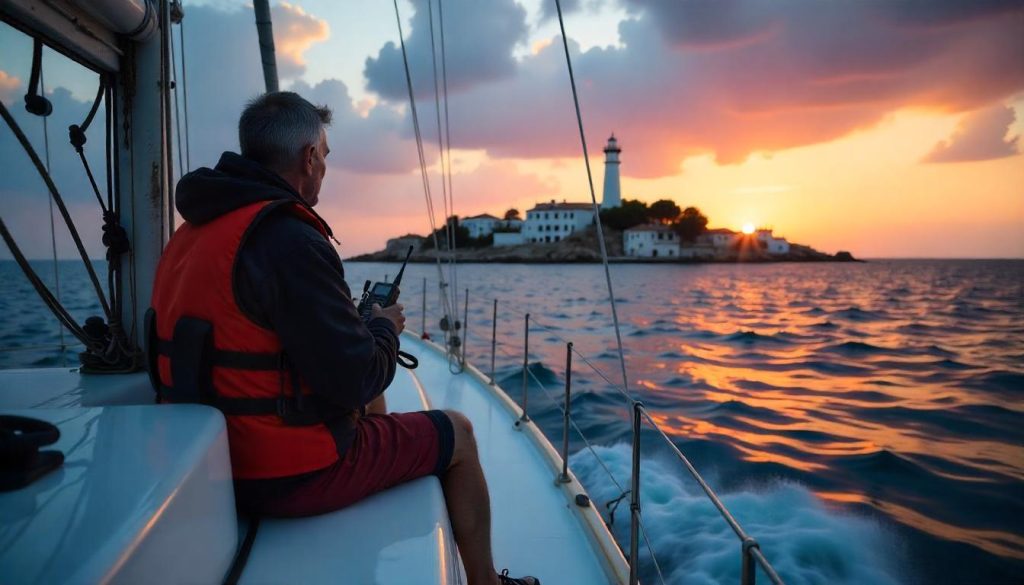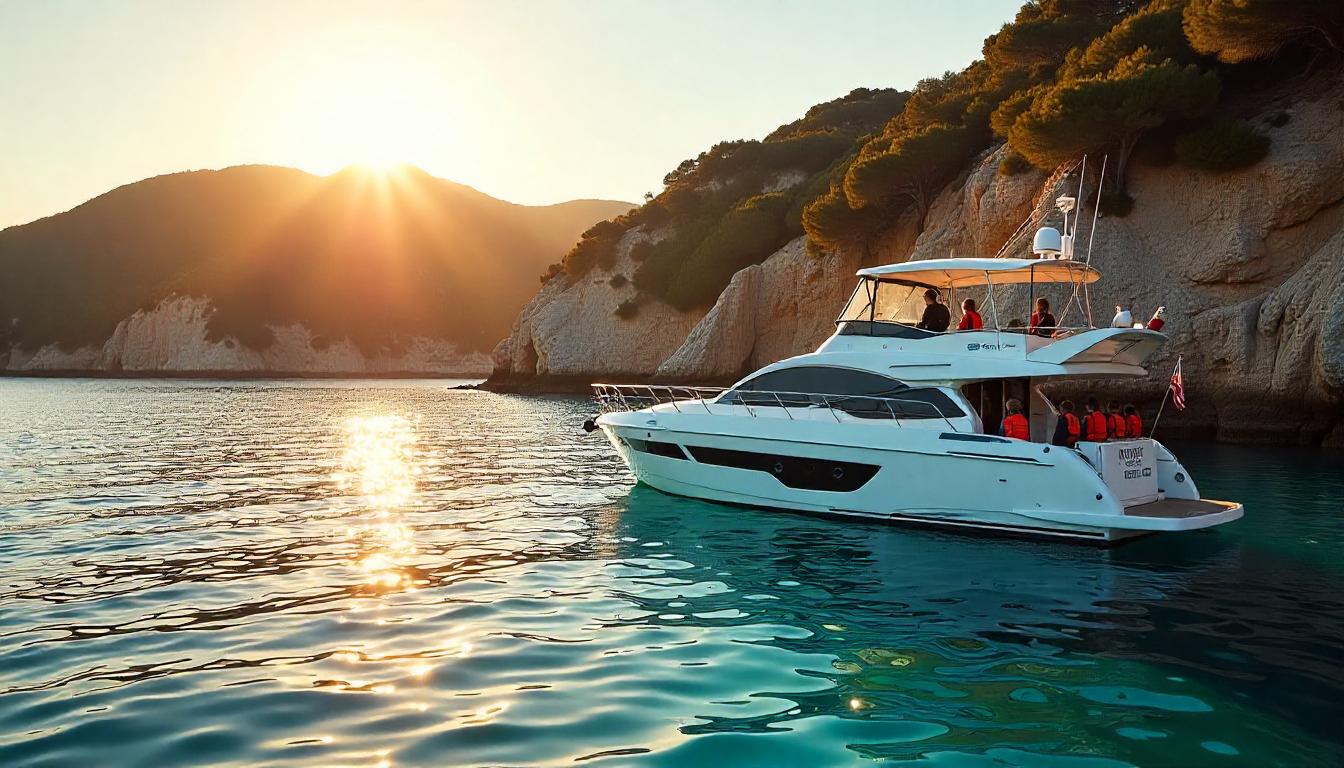Spain’s 8,000 km of coastline, from the Balearic Islands to the Costa de la Luz, offers stunning sailing opportunities, but yachting safety Spain is essential to ensure a secure and enjoyable trip. With diverse weather patterns, busy summer anchorages, and strong winds like the Levante in Tarifa, sailors must be prepared for potential challenges. In this guide, we’ll explore key yachting safety Spain tips, covering weather monitoring, navigation, emergency preparedness, and more, to help you sail Spain’s waters confidently as of April 2025.
Why Prioritize Yachting Safety Spain?
Prioritizing yachting safety Spain protects you, your crew, and your vessel from the risks of sailing in a region with varied conditions. For starters, Spain’s Mediterranean and Atlantic waters can be unpredictable—the Tramontana wind in the Balearics can reach 20 knots, creating rough seas. Moreover, crowded anchorages in peak season, like Playa de Ses Illetes in Formentera, increase the risk of collisions. Consequently, following safety protocols ensures a smooth and secure sailing experience along Spain’s coast.
The Importance of Preparation
Preparation is key to yachting safety Spain. For instance, checking weather forecasts before sailing from Alicante to Tabarca Island can help you avoid sudden storms, which can bring 15-knot winds in summer. Additionally, ensuring your yacht is equipped with safety gear—like life jackets, costing $30 each—can save lives in an emergency. This proactive approach minimizes risks and lets you focus on enjoying Spain’s stunning waters.
Weather Monitoring for Yachting Safety Spain
Monitoring weather is a critical aspect of yachting safety Spain, as conditions can change rapidly across Spain’s regions. The Levante wind in the Costa de la Luz, for example, can hit 25 knots in summer, making sailing near Tarifa challenging. Use apps like Windy, which provides real-time wind data for free, or Meteoblue, costing $10 per year for detailed forecasts. Also, check local marine forecasts—Spain’s AEMET agency offers free updates on wind, waves, and storms, crucial for planning your route.
Adapting to Weather Changes
Adapting to weather changes enhances yachting safety Spain. For example, if the Tramontana wind picks up in the Costa Brava, seek shelter in a cove like Cala S’Alguer, protected from northerly winds, and anchor with depths of 2-3 meters. Next, sail in the morning when winds are typically lighter—around 5 knots in the Balearics—reducing the risk of rough seas. Transitioning to preparation, always have a backup plan, such as an alternative anchorage, if conditions worsen. Thus, staying informed about weather ensures a safer trip.
Navigation and Charts in Yachting Safety Spain
Proper navigation is vital for yachting safety Spain, especially in busy or narrow waters like the Balearic Islands or Alicante’s port. Use digital charts like Navionics, costing $50 per year, for accurate depth and hazard data—essential for avoiding shallow areas near Tabarca Island, where depths can drop to 1 meter. Also, carry paper charts as a backup, costing $30, in case of electronic failure. Additionally, familiarize yourself with local regulations—some areas, like Cabrera National Park, require permits costing $20 per night to anchor.
Navigating Safely in Spain’s Waters
Navigating safely reduces risks significantly. For instance, practice in wider bays like Mahón’s harbor in Menorca before tackling narrow coves like Cala Pregonda, where rocks can be a hazard. Next, use a depth sounder, standard on most charters, to monitor water depth—keep at least 2 meters under the keel in rocky areas like Cabo de las Huertas in Alicante. Transitioning to technology, enable AIS (Automatic Identification System) on your VHF radio, costing $200 to install, to track nearby vessels in busy ports like Palma. Therefore, careful navigation ensures yachting safety Spain.
Safety Gear for Yachting Safety Spain
Having the right safety gear is non-negotiable for yachting safety Spain, as it can be a lifesaver in emergencies. Ensure every crew member has a life jacket—standard ones cost $30, while auto-inflating models are $80, ideal for rough seas in the Costa de la Luz. Also, equip your yacht with a first-aid kit, costing $40, to handle minor injuries like cuts from handling ropes. Additionally, carry a liferaft, costing $1,000, for emergencies like a hull breach, which can occur if you hit a submerged rock.
Using Safety Gear Effectively
Using safety gear effectively enhances yachting safety Spain. For example, conduct a safety briefing before departure—show your crew how to wear life jackets and locate the liferaft, typically stored in the cockpit. Next, keep a flare kit, costing $50, on hand to signal for help—visual distress signals are crucial if you’re stranded off Galicia’s Rías Baixas, where fog can reduce visibility to 50 meters. Transitioning to maintenance, check gear regularly—ensure flares aren’t expired, as they have a 3-year shelf life. Thus, proper use of safety gear ensures preparedness for emergencies.

Emergency Preparedness in Yachting Safety Spain
Emergency preparedness is a cornerstone of yachting safety, as quick action can prevent disasters. Know Spain’s emergency number, 112, which connects you to maritime rescue services for free, and keep a VHF radio, standard on most charters, to call for help on Channel 16. Also, have a grab bag ready—include essentials like water, a flashlight ($10), and a handheld GPS ($150) in case you need to abandon ship. Additionally, register with Spain’s Salvamento Marítimo for free to ensure faster rescue response.
海上での緊急事態への対応
Handling emergencies effectively can save lives. For instance, if a crew member falls overboard near the Costa Brava, throw a lifebuoy, costing $20, and mark the spot on your GPS to circle back—practice this drill before sailing. Next, if your yacht takes on water off Formentera, use the bilge pump, standard on most yachts, and head for the nearest port like Marina Ibiza, 10 nautical miles away. Transitioning to communication, ensure your VHF radio battery is charged—replacements cost $30—to call for help. Therefore, being prepared for emergencies ensures yachting safety Spain.
Crew Training for Yachting Safety Spain
Crew training is essential for yachting safety, especially if you’re sailing without a professional skipper. Ensure at least one person has a sailing certification like the RYA Day Skipper, costing $500 for a 5-day course, which covers navigation and safety. Also, train your crew in basic skills—teach them how to reef sails in 15-knot winds, a common scenario in the Canaries, to prevent capsizing. Additionally, practice man-overboard drills, which take 10 minutes to run, to build confidence in emergencies.
Building Crew Confidence
Building crew confidence improves safety significantly. For example, assign roles before departure—one person handles the helm, another manages lines, ensuring smooth operations in busy ports like Barcelona’s Port Vell. Next, conduct a mock emergency drill—simulate a fire by sounding an alarm and have the crew grab the fire extinguisher, costing $40, to put out an imaginary blaze. Transitioning to teamwork, encourage communication—use hand signals in noisy conditions, like during a 20-knot Levante wind in Tarifa. Thus, a well-trained crew enhances yachting safety Spain.
Local Regulations and Etiquette in Yachting Safety Spain
Understanding local regulations and etiquette is crucial for yachting safety, as it prevents fines and ensures harmony with other sailors. In protected areas like Cabrera National Park, anchoring is prohibited outside designated buoys—permits cost $20 per night, and fines for violations are $200. Also, respect speed limits—5 knots in Alicante’s port avoids wake damage to other boats, and exceeding this can result in a $100 fine. Additionally, follow anchoring etiquette—keep 50 meters between yachts in crowded spots like Playa de Muro in Mallorca.
Respecting Spain’s Waters
Respecting local rules and etiquette ensures safety and goodwill. For instance, in the Balearics, don’t anchor over Posidonia seagrass meadows—use mooring buoys to protect this ecosystem, as fines for damage can reach $500. Next, in busy anchorages like Cala Saona in Formentera, drop anchor carefully to avoid tangling with other boats’ chains—use a fender, costing $15, to mark your anchor spot. Transitioning to courtesy, avoid loud music late at night in marinas like Port de Mahón, respecting other sailors’ rest. Therefore, following regulations and etiquette enhances yachting safety.
Practical Tips for Yachting Safety Spain
A few practical tips can further ensure yachting safety Spain. First, always file a float plan—share your itinerary with a friend or marina staff, like at Real Club Náutico de Palma, so they know your route in case of an emergency. Next, carry extra water—2 liters per person per day, costing $1 per liter, prevents dehydration during long sails in the Canaries, where temperatures can hit 24°C. Also, check your yacht’s engine before departure—oil changes cost $50 and prevent breakdowns mid-trip.
Staying Proactive on the Water
Staying proactive keeps you safe. For example, monitor your battery levels—solar chargers, costing $100, ensure your electronics stay powered during a week-long trip in the Costa del Sol. Next, in foggy conditions off Galicia, use a foghorn, costing $20, to signal your position—sound it every 2 minutes as per maritime rules. Transitioning to health, apply sunscreen regularly—SPF 50 costs $10 and protects against UV rays during summer sails in Ibiza. Thus, proactive measures ensure a secure yachting experience.
Challenges of Ensuring Yachting Safety Spain
Ensuring yachting safety Spain can present challenges. First, peak season (July-August) means crowded anchorages—Playa de Ses Illetes can have 20 yachts, increasing collision risks. Additionally, sudden weather changes, like a 20-knot Tramontana wind in the Balearics, can catch sailors off guard, requiring quick action. Also, language barriers can complicate emergencies—marina staff in smaller ports like Port de Ciutadella may not speak English, making communication tricky. However, these issues can be managed.
Overcoming Safety Challenges
Sail in off-peak seasons like May or September—anchorages like Cala Turqueta in Menorca are less crowded, reducing collision risks. For weather, have a flexible itinerary—your captain can suggest sheltered coves like Cala Macarella if winds pick up. For language, learn basic Spanish phrases—“emergencia” (emergency) can help in a crisis, and phrasebooks cost $5. Transitioning to solutions, you can navigate challenges effectively. Thus, preparation ensures yachting safety Spain despite obstacles.
Why Focus on Yachting Safety Spain?
Focusing on yachting safety Spain ensures a secure and enjoyable sailing experience, from the Balearics to the Canaries, allowing you to explore Spain’s stunning coast with peace of mind. Safety measures like weather monitoring, proper navigation, and emergency preparedness protect you from risks while enhancing your trip. For a worry-free sailing adventure, this is the way. Therefore, yachting safety Spain is essential for every sailor.
A Safe Yachting Journey in Spain
Every precaution creates confidence. For instance, monitoring weather avoids a stormy sail in the Costa Brava. Or, a well-trained crew handles emergencies off Tabarca Island with ease. This preparation ensures a spectacular trip. Thus, yachting safety Spain leads to memories you’ll cherish.
Final Thoughts on Yachting Safety Spain
Yachting safety Spain lets you explore Spain’s diverse waters, from serene coves to bustling ports, with confidence, ensuring every journey is both thrilling and secure. With careful preparation, the right safety gear, and a proactive mindset, you’ll create a sailing trip that’s safe and unforgettable. So, gear up, stay vigilant, and let Spain’s shores captivate you—one wave at a time.


